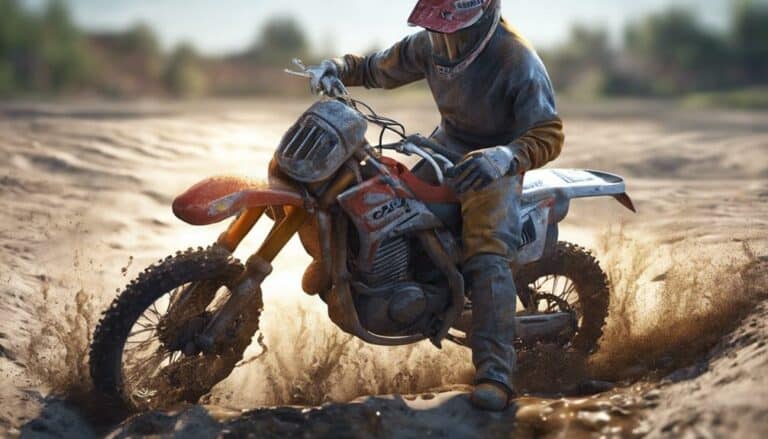As you stand over your dirt bike, envision the sleek lines and rugged tires that have carried you through countless adventures. The anticipation builds as you prepare to undertake on the essential task of changing its oil.
Each step holds the key to ensuring your bike's engine runs smoothly and efficiently. So, what are these essential steps that will keep your trusty ride in top condition? Let's uncover the secrets to maintaining your dirt bike's heart and soul.
Key Takeaways
- Drain old oil completely and inspect drain bolt for debris.
- Remove and replace oil filter, ensuring proper installation.
- Refill with fresh oil to correct level, avoiding overfilling.
- Dispose of old oil responsibly, following local regulations for recycling.
Drain the Old Oil
To begin draining the old oil from your dirt bike, use a suitable wrench to carefully remove the drain bolt located on the engine. Position an oil pan beneath the bike to catch the oil as it drains out. Allow the oil to flow freely to make sure all contaminants are removed from the engine. It's important to let the oil drain completely before proceeding further with the oil change process.
Once the oil has drained out completely, inspect the drain bolt for any debris or contaminants. Clean the bolt thoroughly to prevent any foreign particles from entering the engine when you screw it back in place. Tighten the drain bolt securely using the wrench to avoid any potential leaks during operation.
Remove and Replace Oil Filter
When replacing the oil filter on your dirt bike, make sure to use the appropriate tools for a secure removal and installation. Begin by locating the oil filter cover and carefully removing it to access the oil filter. Use a filter wrench or pliers to gently remove the old filter, being cautious not to spill any old oil around. Inspect the old filter for any debris or signs of damage that could indicate engine issues. Before installing the new filter, lubricate the rubber gasket with fresh oil to guarantee a proper seal. Hand tighten the new filter first and then use a filter wrench to secure it to the manufacturer's recommended torque specification. Double-check that the filter is securely in place to prevent leaks. Below is a table to summarize the steps for removing and replacing the oil filter:
| Steps to Remove and Replace Oil Filter |
|---|
| 1. Locate oil filter cover |
| 2. Remove the old filter with a new one |
| 3. Inspect old filter for damage/debris |
| 4. Lubricate new filter's gasket |
| 5. Secure new filter in place |
Refill With Fresh Oil
After replacing the oil filter on your dirt bike, the next step is to refill it with the correct amount and type of fresh oil recommended by the manufacturer. Follow these steps to make sure a successful oil refill:
- Use a funnel to pour the new oil into the oil fill hole to prevent spills and accurately measure the amount of oil being added.
- Check the oil level using either the dipstick or sight glass to confirm that the oil is at the appropriate level for best engine performance.
- Once the oil has been added, tighten the oil fill cap securely to prevent leaks and maintain the proper circulation of oil within the engine.
- Before starting the engine, double-check that the oil has been refilled correctly to avoid potential damage due to low oil levels.
Check Oil Level
Check the oil level in your dirt bike using the dipstick or sight glass, making sure the bike is on a level surface for accurate measurement. To get the most precise reading, it's recommended to check the oil level when the engine is warm but turned off to allow the oil to settle back into the oil pan. Make sure the oil level falls between the minimum and maximum marks on the dipstick or sight glass to guarantee proper lubrication of engine parts. If the oil level is low, it's essential to add fresh oil to avoid any damage to your dirt bike's engine components.
Regularly checking the oil level is vital for the overall health of your dirt bike. It helps in maintaining the proper lubrication needed for the engine to run smoothly. Additionally, changing the oil at the recommended intervals and monitoring the oil level can prevent premature wear and tear on engine parts.
Dispose of Old Oil Properly
Properly disposing of old oil involves taking it to a recycling center or an authorized oil collection facility to prevent environmental harm. Improper disposal of used oil can have devastating effects on the environment. Here are some important steps to make sure you dispose of old oil properly:
- Never Pour Down Drains: Avoid pouring used oil down drains, on the ground, or into storm drains. This can contaminate water sources and harm wildlife.
- Check Local Regulations: Consult local regulations or waste management authorities for specific guidelines on oil disposal in your area.
- Recycle for Environmental Protection: Recycling used oil not only helps to reduce the need for new oil production but also minimizes the environmental impact of improper disposal.
- Protect Our Ecosystem: By disposing of old oil responsibly, you're contributing to the preservation of our ecosystem and safeguarding the planet for future generations.
Conclusion
Now that you've completed the steps for performing an oil change on your dirt bike, you've given your engine a fresh lease on life. Like a well-oiled machine, your bike is ready to tackle any terrain with ease.
So next time you hit the trails, remember the importance of regular maintenance to keep your ride running smoothly and efficiently.
Happy riding!

